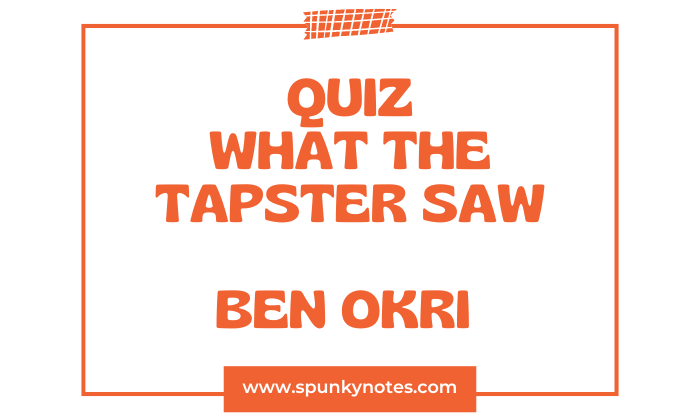
What The Tapster Saw Quiz
1. What is the main profession of the protagonist?
A) Farmer
B) Blacksmith
C) Tapster
D) Hunter
2. What does the tapster dream about the night before his accident?
A) Finding a hidden treasure
B) Falling from a palm tree
C) Winning the lottery
D) Meeting a beautiful woman
3. Who is Tabasco, and what is his role in the story?
A) The tapster’s best friend, a herbalist
B) A rival tapster in the village
C) A local shopkeeper
D) A spirit guide from the tapster’s dreams
4. What message does the sign the tapster sees in the forest warn about?
A) Beware of wild animals
B) Trespassing is forbidden
C) Polluted water ahead
D) Road construction in progress
5. What unusual thing happens to the tapster when he falls from the tree?
A) He wakes up unharmed
B) He experiences a near-death experience
C) He gains magical powers
D) He travels to a different dimension
6. Where does the story take place?
A) A bustling city
B) A modern suburb
C) A remote village
D) A tropical island
7. What is the significance of the palm trees in the story?
A) They represent wealth and prosperity
B) They symbolize the tapster’s livelihood
C) They embody the connection to nature
D) All of the above
8. What does the “Delta Oil Company” sign represent in the story?
A) Progress and development
B) Threat to nature and tradition
C) A symbol of modernity
D) A plot device for suspense
9. What is the likely purpose of the turtles the tapster sees in his dream world?
A) They represent wisdom and guidance
B) They symbolize a connection to the ancestors
C) They foreshadow future events
D) They are a test for the tapster
10. How does the story utilize magical realism?
A) By including fantastical creatures
B) By blurring the lines between reality and dream
C) Through exaggerated characters and events
D) By using advanced technology
11. Who is the author of “What the Tapster Saw”?
A. Chinua Achebe
B. Wole Soyinka
C. Ben Okri
D. Amos Tutuola
12. What significant event changes the tapster’s routine?
A. A festival
B. A mysterious visitor
C. A theft
D. A fall
13. How does the tapster feel about the event he witnessed?
A. Excited
B. Indifferent
C. Troubled
D. Amused
14. What theme is prominent in “What the Tapster Saw”?
A. Love
B. Corruption
C. Education
D. Adventure
15. Which literary device is most evident in “What the Tapster Saw“?
A. Flashback
B. Foreshadowing
C. Irony
D. Symbolism
16. How does the tapster respond to the mysterious event?
A. He investigates it himself
B. He ignores it
C. He reports it to the authorities
D. He tells his friends
17. What central theme is highlighted in “What The Tapster Saw”?
A) Importance of hard work and dedication
B) The power of friendship and loyalty
C) The conflict between tradition and progress
D) The consequences of disobeying warnings
18. How does the tapster’s dream world challenge his understanding of reality?
A) It reveals hidden truths about his past
B) It forces him to confront his mortality
C) It introduces him to new cultures
D) It grants him wishes and desires
19. What is the significance of the tapster marking the palm tree in his dream?
A) It represents a desire to leave his mark
B) It symbolizes leaving the past behind
C) It foreshadows future danger
D) It acts as a marker to return to the dream world
20. Based on their interaction, What can we infer about the tapster’s relationship with Tabasco?
A) Deep trust and understanding
B) A strained and distant friendship
C) A competitive professional rivalry
D) A sense of mutual admiration
21. How does the story’s ending leave the reader with a sense of ambiguity?
A) The tapster’s fate remains unclear
B) The meaning of the dream world is unexplained
C) The cause of the tapster’s fall is unknown
D) All of the above
22. The story mentions a “borehole” near the river. How might this detail contribute to the theme of progress vs. tradition?
A) It represents a source of clean water for the community.
B) It symbolizes the intrusion of technology into a natural environment.
C) It foreshadows a future discovery by the tapster.
D) It has no significant meaning to the story’s themes.
23. The tapster encounters several strange sights in his dream world. Which of these is a symbolic representation?
A) A single palm tree standing alone.
B) Earth mounds and gravestones.
C) A river flowing uphill.
D) A talking animal giving advice.
24. How does the repetition of the number “three” throughout the story (three turtles, three days dead) contribute to the narrative?
A) It foreshadows a coming misfortune.
B) It establishes a sense of rhythm and mystery.
C) It represents a specific cultural belief.
D) It has no particular significance.
25. The story explores the concept of death and the afterlife. How does the tapster’s experience in the dream world challenge traditional views of these concepts?
A) It presents death as a peaceful and final transition.
B) It shows the afterlife as a place of punishment.
C) It depicts a more ambiguous and fluid understanding of death.
D) It focuses solely on the physical aspects of dying.
26. The story’s ending leaves the reader with a sense of wonder and uncertainty. What is the most likely purpose of this ambiguity?
A) It invites the reader to interpret the events themselves.
B) It suggests the tapster is unreliable and prone to fantasy.
C) It sets the stage for a potential sequel.
D) It highlights the limitations of human understanding.

